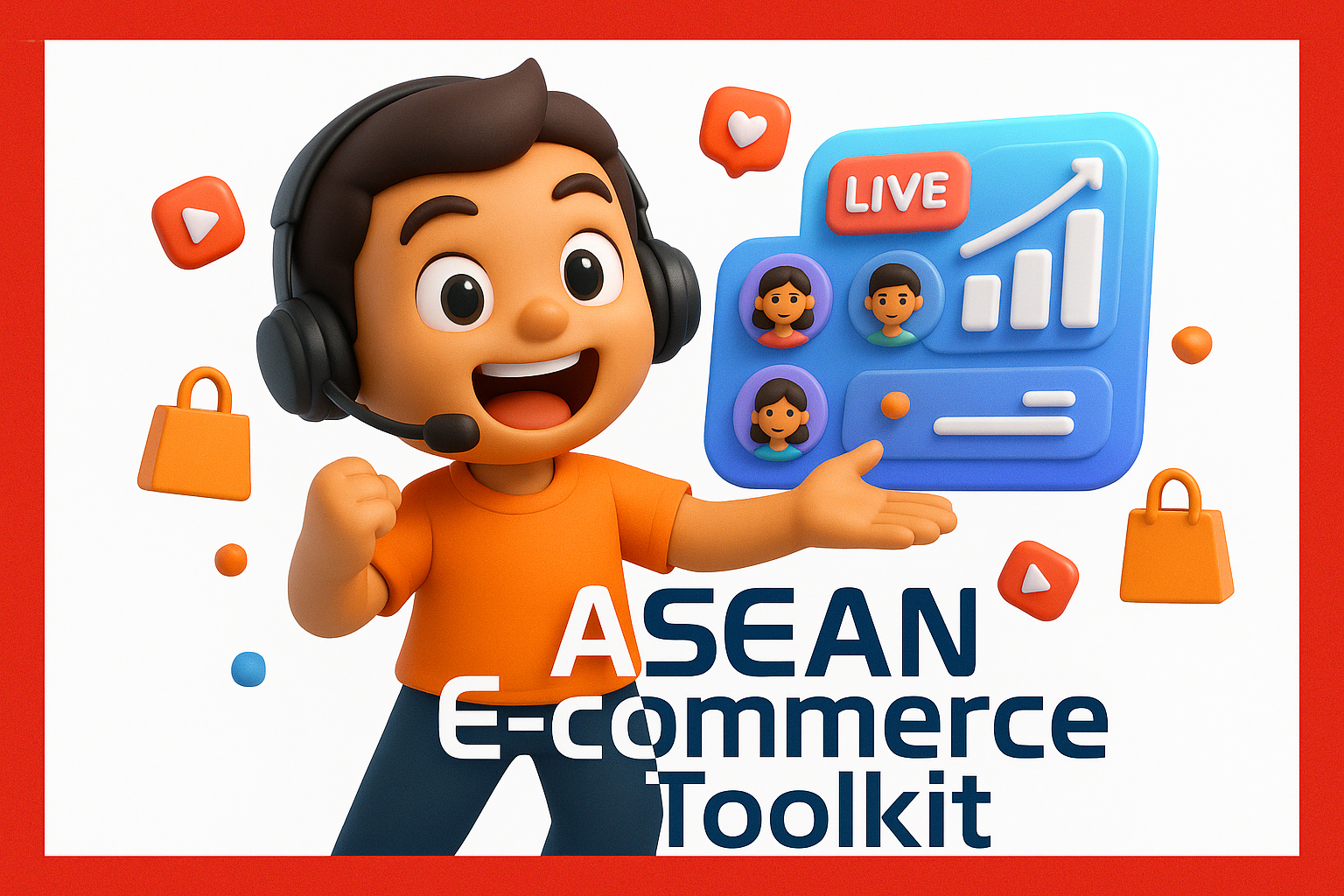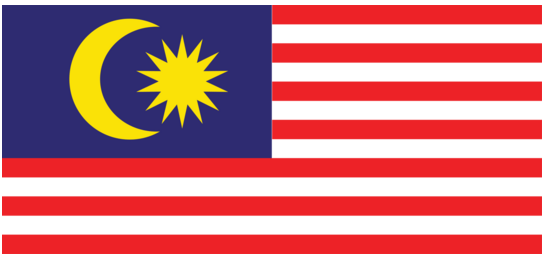
ASEAN E-commerce Toolkit: Live Streaming & Influencer Partnerships
ASEAN E-commerce Growth Tools
Introduction: ASEAN's E-commerce Boom and the Emergence of Live Streaming & Influencer Marketing
Southeast Asia’s e-commerce market is poised for explosive growth, with projections reaching US$133.62 billion in 2025 and a compound annual growth rate (CAGR) of 14% driving sales to US$410 billion by 203015. This surge reflects a decade-long transformation, where digital infrastructure, mobile adoption, and cashless payments have reshaped consumer behavior. Major platforms like Shopee and Lazada now dominate 70% of regional sales, achieving profitability through market consolidation and fee increases1. However, sustaining this growth demands innovation – and live streaming and influencer partnerships have emerged as critical tools for brands aiming to scale.
These strategies thrive in Southeast Asia’s social commerce landscape. Platforms like TikTok Shop and Shopee Live leverage engaging content to convert viewers into buyers, while micro-influencers tap into grassroots trust to drive regional demand. As cross-border trade expands – particularly in Indonesia, Vietnam, and Thailand – localized campaigns paired with logistics optimization become essential for capturing diverse markets4.
For businesses navigating this competitive space, this article outlines actionable strategies to harness live commerce and influencer networks. From optimizing conversion tactics to measuring campaign ROI, we’ll unpack how these tools align with ASEAN’s digital evolution.
Transition to Next Section
The next section delves into the evolving e-commerce ecosystem, analyzing dominant platforms, AI-driven trends, and cross-border strategies shaping the region’s growth.
The Current Landscape: Dominant Platforms and Rising Trends
Southeast Asia’s e-commerce landscape is defined by three dominant platforms – Shopee (https://shopee.com/), Lazada (https://www.lazada.com/), and TikTok Shop – which collectively command over 70% of regional sales5. Their strategies, from live streaming adoption to AI-driven personalization, set the pace for innovation in this $184 billion market (2024)2.
Major Players and Live Commerce Leadership
Shopee and Lazada have solidified their positions through profitability achieved via market consolidation, fee increases, and core business focus1. Shopee, for instance, secured 57% market share in Thailand and 62% in Vietnam, leveraging ecosystem synergies between gaming (Garena) and digital wallets (Monee)8. Lazada, owned by Alibaba, has prioritized logistics optimization and vertical integration into warehousing and delivery to enhance operational efficiency2. Both platforms are pioneers in live commerce, with Shopee Live and Lazada Live enabling real-time product demos and influencer-led sales.
Meanwhile, TikTok Shop is carving a niche through hyper-localized campaigns and social-first shopping experiences. While its regional market share lags behind incumbents, its rapid expansion in Indonesia and the Philippines – driven by viral content and micro-influencers – poses a threat to established players6.
| Platform | Key Strengths | Market Share (Example Countries) |
|---|---|---|
| Shopee | Localization, ecosystem integration (e-wallets, gaming) | Thailand (57%), Vietnam (62%)[8] |
| Lazada | Logistics expertise, cross-border e-commerce | Thailand (Lazada dominates 79% with Shopee)[6] |
| TikTok Shop | Viral shoppertainment, micro-influencers | Emerging in Indonesia and the Philippines |
Emerging Trends Shaping the Market
1. AI-Driven Personalization and Shoppertainment
Platforms are investing in AI-powered recommendation engines to create tailored shopping journeys. For example, Shopee uses AI to analyze user behavior and surface products during live streams, while Lazada employs machine learning for inventory forecasting4. “Shoppertainment” – blending entertainment with commerce – is becoming central. TikTok Shop leverages short-form videos and challenges to engage users, while Shopee integrates gamified elements (e.g., treasure hunts) into live streams.
2. Cross-Border Expansion and Logistics Innovation
With Indonesia projected to hit $204 billion in e-commerce revenue by 20287, platforms are prioritizing cross-border trade. Lazada’s focus on seamless logistics (e.g., last-mile delivery networks) addresses challenges in fragmented markets like Indonesia and the Philippines2. Shopee, meanwhile, taps regional hubs (e.g., Singapore for ASEAN-wide distribution) to streamline international sales4.
3. Mobile Payments and Frictionless Checkout
The rise of digital wallets (e.g., ShopeePay, GrabPay) has reduced payment friction, particularly in cash-reliant markets like Thailand and the Philippines. Platforms now offer instant checkout options tied to these wallets, boosting conversion rates by up to 30%6. New entrants emphasizing credit-backed financing (e.g., BNPL models) are disrupting traditional funding reliance on venture capital4.
Transition to Next Section
As these platforms evolve, live streaming emerges as a critical tool for scaling brands in ASEAN’s hyper-social markets. The next section dives into actionable strategies for implementing live commerce, from platform selection to campaign optimization – essential for capturing the region’s projected $410 billion e-commerce market by 20302.
Live Streaming as an ASEAN E-commerce Growth Tool
To harness live streaming effectively, brands must master both platform dynamics and audience engagement strategies. Below is a tactical playbook tailored to ASEAN markets, combining lessons from regional pioneers and platform-specific best practices.
Step 1: Platform Selection and Configuration
The choice between TikTok Shop and Lazada Live hinges on target demographics and campaign objectives.
| Platform | Core Strengths | Ideal For | Key Tools |
|---|---|---|---|
| TikTok Shop | Viral shoppertainment, Gen Z/young millennials | Trend-driven products (e.g., beauty, tech gadgets) | Duets, Challenges, In-App Product Tags, Live Polls |
| Lazada Live | Family-oriented shopping, high-value goods | Home appliances, luxury items, health products | Extended broadcasts (up to 4 hours), Multi-host collaboration, Coupon Drops |
TikTok Shop excels in creating FOMO-driven campaigns through short-form, high-energy streams. For example, a beauty brand might partner with micro-influencers to demonstrate mascara application in 60-second clips, triggering instant purchases via in-app product tags6. Lazada Live, meanwhile, thrives on long-form storytelling – ideal for explaining complex products like smart home devices. Its multi-host feature allows brands to split roles: one host for demos, another for handling real-time Q&A, and a third for promotions6.
Step 2: Conversion Optimization Tactics
ASEAN consumers demand immediacy and social proof. Implement these tactics to boost CTR and sales:
-
Pre-Live Hype Building
- TikTok Shop: Leverage viral challenges 24-48 hours before streams. Example: A mystery box campaign where viewers guess contents using emojis, with clues dropped via Reels6.
- Lazada Live: Use countdown stickers and event pages to drive anticipation. Include influencer teasers (e.g., "Join Chef Tasyi at 8 PM for kitchen appliance deals!") to pre-qualify viewers5.
-
Real-Time Interaction
-
Post-Live Retargeting
- Re-upload highlights to playlists like "Top Deals This Week" or "Product Demos." Use platform analytics to target viewers who abandoned carts during the live session4.
Step 3: Successful Campaign Case Studies
Case 1: TikTok Shop x Shopee in Indonesia
In 2022, Shopee leveraged livestream commerce to reach 69% of Indonesian shoppers, with hosts blending humor and product demos to sell home care items5. A standout tactic: Hosts used props from viewers’ homes (e.g., dirty dishes) to demonstrate cleaning products, creating relatable scenarios that spurred purchases.
Case 2: Lazada Live in Thailand
A regional appliance brand partnered with a family influencer duo to livestream a "Smart Home Makeover" series. Over four sessions, they showcased interconnected devices (lights, security cameras), offering bundle discounts. Each session featured live installation walkthroughs, eliminating purchase hesitation6.
Case 3: Cross-Platform Collaborations
A Singaporean fashion brand ran a synchronized campaign:
- Pre-Live: TikTok influencers posted outfit-of-the-day challenges.
- Live: Lazada Live hosted a "Model Casting" stream where viewers voted for ensembles.
- Post-Live: Winning designs were sold via exclusive Lazada listings. This multichannel approach drove 40% higher engagement than solo efforts6.
Step 4: Content Creation Best Practices
Engagement Hacks for Streamers
- Embrace "Shoppertainment": Use games like "Spin the Wheel" to reveal discounts or "Lyric Challenges" where viewers guess song titles for discounts8.
- Leverage Local Nuances:
- Philippines: Focus on family-oriented products (e.g., bulk grocery deals).
- Thailand: Highlight time-saving solutions (e.g., meal prep kits).
- Tech Integration:
- AI Chatbots: Deploy on Lazada Live to handle repetitive Q&A (e.g., "Is delivery free?").
- AR Filters: On TikTok Shop, let viewers "try on" virtual jewelry or makeup7.
Common Pitfalls to Avoid
- Overcomplication: Keep product lines under 10 items per stream to prevent "decision fatigue."
- Poor Lighting/Audio: Invest in a ring light and lavalier mic – ASEAN viewers expect high production quality6.
- Ignoring Regional Preferences: In Muslim-majority markets, ensure hijab-friendly fashion demonstrations5.
Transition to Next Section
By mastering live commerce, brands position themselves to capture ASEAN’s growing $133.6B+ e-commerce market. The next section explores how influencer partnerships amplify reach – whether through micro-niches in Indonesia or cross-border KOL collaborations across Southeast Asia.
Leveraging Influencer Partnerships in ASEAN Markets
Influencer marketing in ASEAN has evolved into a precision-driven strategy, with brands now tailoring approaches to micro vs. macro influencers, integrating platform-specific affiliate programs, and navigating compliance nuances to maximize ROI. Here’s how to optimize these partnerships for scale and impact.
Micro vs. Macro Influencers: Trust and Reach in ASEAN
ASEAN consumers prioritize authenticity over reach, making nano-influencers (1K–10K followers) the most trusted tier. In Southeast Asia, 46% of buyers prefer nano-influencer endorsements over celebrities (20%) or macro-influencers (17%)2. Their relatability stems from sharing personal experiences rather than polished content, aligning with ASEAN’s cultural emphasis on word-of-mouth recommendations.
For brands seeking broader reach, micro-influencers (10K–100K followers) dominate Thailand’s influencer ecosystem, with 12,000 active creators — nearly double the number of nano-influencers6. While less trusted than micro-influencers, they offer cost-effective scalability, particularly for localized campaigns.
| Influencer Tier | Trust Level (SEA) | Regional Prevalence (Thailand Example) | Cost Efficiency |
|---|---|---|---|
| Nano | 46% buyers trust | 6,000 creators | High |
| Micro | 15% buyers trust | 12,000 creators (most common) | Moderate |
| Macro | 17% buyers trust | 2,600 creators | Low |
| Celebrities | 20% buyers trust | 528 creators (smallest tier) | Very Low |
Platform Integration: Shopee Affiliate Programs and Beyond
Shopee’s affiliate program has become a cornerstone of influencers’ monetization, enabling creators to earn commissions through referral links. The platform’s success lies in its ecosystem synergy — influencers leverage gaming platforms (like Garena )and digital wallets (ShopeePay) to drive traffic5. For example:
- Shopee Live: Hosts 60-90 minute streams where influencers demo products in real-time, integrating affiliate links for seamless checkout.
- Regional Benchmarks: In Indonesia, influencer ad spending surged from $27 million (2017) to $223 million (2024), reflecting Shopee’s dominance5.
TikTok Shop, meanwhile, focuses on viral product challenges, such as asking viewers to “duet” with influencers for discount codes. This strategy thrives in Gen Z-heavy markets like the Philippines and Indonesia8.
Compliance and Regional Nuances
ASEAN’s fragmented regulations require localized compliance strategies:
- Content Moderation: Regulations vary — e.g., Indonesia enforces strict guidelines on health product claims, while Thailand restricts alcohol promotions.
- Data Privacy: Platforms like Lazada and Shopee must comply with Southeast Asia’s evolving data protection laws, often requiring influencers to disclose partnerships visibly.
- Cultural Sensitivity: In Muslim-majority markets (Malaysia, Indonesia), influencers avoid revealing clothing and emphasize halal-certified products5.
Measuring Influencer ROI: Regional Benchmarks
To gauge effectiveness, compare metrics against ASEAN benchmarks:
| Metric | High-Performing Campaigns | Average Campaigns |
|---|---|---|
| Engagement Rate | 5-10% | 2-5% |
| Conversion Rate | 3-5% | 1-2% |
| Cost Per Lead | $2-5 | $5-10 |
In Indonesia, where influencer ad spending is projected to reach $257 million in 2025, brands achieve higher ROI by pairing nano-influencers with ultra-localized content5. For cross-border campaigns, track UTM parameters to isolate country-specific performance.
Transition
While influencer partnerships are pivotal, their potential multiplies when combined with live streaming. The next section explores synergistic strategies — like embedding nano-influencers into Shopee Live streams or using TikTok challenges to drive traffic to Lazada campaigns — to leverage ASEAN’s social commerce ecosystem.
Combining Live Streaming and Influencer Strategies for Maximum Impact
To unlock the full potential of ASEAN’s social commerce landscape, brands must merge live streaming and influencer partnerships into seamless campaigns. This synergy transforms viewers into loyal buyers by blending real-time interactivity with trusted endorsements. Below are advanced tactics proven in Southeast Asia’s competitive markets.
Cross-Promotion Models for Multichannel Impact
The most effective campaigns start weeks before the live stream. For example:
-
Pre-Live Hype:
- TikTok Tactic: Launch a viral challenge (e.g., “#FashionHaulSwap”) where users post videos using a branded hashtag. Partner with micro-influencers to kickstart participation. Here is the link to the official website of TikTok
- Lazada Tactic: Tease upcoming streams via in-app notifications and influencer collaborations (e.g., “Our favorite mom-blogger will unbox nursery essentials live on June 15!”). Here is the link to the official website of Lazada
-
Live Stream Integration:
- Embed nano-influencers directly into Shopee Live or TikTok Shop broadcasts. For instance, a beauty brand might invite a micro-influencer to demonstrate a product during a stream, while another hosts a Q&A for viewers. Here is the link to the official website of Shopee
- Use AI-driven analytics to identify top-performing influencers in real time, adjusting content to highlight their segments.
-
Post-Live Retargeting:
- Repurpose highlights into shorter reels or carousel posts, tagging influencers for continued exposure.
- Retarget viewers who engaged with the stream but didn’t convert using platform-specific ads (e.g., Lazada’s coupon-based retargeting).
Shoppertainment Integration with KOLs
Influencers aren’t just salespeople—they’re entertainers. Here’s how to merge shoppertainment with key opinion leader (KOL) strategies:
| Tactic | Example | Platform |
|---|---|---|
| Live Challenges | “Guess the Discount!” – Viewers send comments to win coupons. | TikTok Shop |
| Interactive Segments | Influencers let viewers vote on product bundles via live polls. | Lazada Live |
| AR Try-On | Viewers apply virtual makeup during streams, with influencers providing tutorials. | TikTok Shop |
These methods leverage ASEAN’s love for interactive content, particularly in markets like Indonesia and Thailand, where mobile-first consumption dominates3.
AI Tools for Real-Time Influencer Analytics
Platforms like Shopee and Lazada now offer backend tools to track influencer performance during live streams. Key AI applications include:
- Predictive Analytics:
- Identify which influencer segments drive the highest conversions during the stream. For example, if a beauty influencer’s lipstick demo boosts sales by 40%, prioritize her content in future campaigns.
- Sentiment Analysis:
- Monitor viewer comments in real time to address concerns (e.g., “Is this product halal?”) and adjust messaging.
- Dynamic Ad Insertion:
- Use AI to auto-tag products in streams, enabling viewers to purchase directly from the video4.
Practical Campaign Planning Templates
Template 1: Cross-Platform Campaign Flow
| Stage | Action | Tools/Resources |
|---|---|---|
| Pre-Live | Launch TikTok challenge + influencer teasers | Brand hashtag, influencer contracts |
| Live | Stream on Lazada/TikTok with real-time influencer analytics | AI tracking, UTM links |
| Post-Live | Repurpose content + retarget viewers | Platform analytics, retargeting ads |
Template 2: SWOT Analysis for Influencer Partnerships
| Strengths | Weaknesses | Opportunities | Threats |
|---|---|---|---|
| High trust from nano-influencers | Limited reach of micro-influencers | Cross-border campaign expansion | Compliance risks in fragmented regions |
By aligning these strategies, brands can capitalize on ASEAN’s $410 billion e-commerce projection while outpacing competitors1.
Transition
As brands master these tactics, they’ll face new challenges: from navigating localized regulations to measuring ROI across diverse markets. The next section explores strategies for overcoming these hurdles, ensuring campaigns stay compliant and effective in ASEAN’s complex ecosystem.
Navigating Challenges: Localization, Compliance, and Measurement
ASEAN’s e-commerce boom is tempered by steep hurdles: cultural nuances demand meticulous adaptation, fragmented regulations create compliance pitfalls, and legacy measurement tools often fail to capture campaign nuances. Let’s dissect these challenges and outline actionable solutions.
Cultural Localization: Beyond Language Translations
Localization extends far beyond translating product descriptions. Cultural preferences shape everything from product selection to content tone. For instance:
- Indonesia prioritizes family-centric messaging, making bulk grocery bundles a staple for live commerce campaigns7.
- Thailand favors time-saving solutions, driving demand for meal-prep kits and smart home devices7.
- Muslim-majority markets require hijab-friendly fashion demonstrations and halal certification displays5.
Platforms like Shopee and Lazada mitigate these challenges through hyper-localized strategies:
- Regional payment integrations: Shopee supports OVO and GoPay wallets in Indonesia, while Lazada partners with GrabPay in Southeast Asia7.
- Platform-specific content: TikTok Shop thrives on short-form videos in the Philippines, whereas Lazada Live favors 4-hour broadcasts in Thailand5.
- Cultural compliance checks: Brands must audit influencers’ content for regional taboos (e.g., avoiding alcohol promotions in Indonesia)6.
| Region | Key Localization Tactics | Example Platform |
|---|---|---|
| Indonesia | Family-oriented bundles + digital wallet integration | Shopee |
| Thailand | Time-saving solutions + multi-host live streams | Lazada Live |
| Philippines | Viral challenges + nano-influencer collaborations | TikTok Shop |
Regulatory Compliance: Navigating ASEAN’s Patchwork Laws
Data privacy laws vary dramatically across ASEAN nations, requiring tailored compliance strategies:
- Thailand: Enforces strict PDPA (Personal Data Protection Act) for cross-border transfers. Brands must adopt Binding Corporate Rules (BCR) certified by the PDPC, ensuring data flow compliance between affiliates6.
- Malaysia: Revised CBPDT (Cross Border Personal Data Transfer) Guidelines mandate detailed privacy policies and breach notification protocols8.
- Regional Gaps: The RCEP trade agreement lacks enforceable provisions for cross-border data flows and algorithm transparency, leaving businesses to navigate inconsistent regulations3.
Compliance Workarounds:
- Blockchain Integration: SHEIN and TikTok Shop use blockchain for traceability and payment compliance5.
- Localized Consent Management: Require explicit user agreements in markets with stricter privacy laws (e.g., Thailand’s PDPA)6.
- AI-Driven Audits: Automated systems flag non-compliant influencer content (e.g., health claims in Indonesia)6.
Advanced Measurement: Beyond Vanities Metrics
Traditional metrics like engagement rates and conversion rates often fail to capture cross-border campaign complexity. Brands should adopt:
- UTM Tracking: Isolate performance by country, influencer tier, and platform (e.g.,
utm_source=tiktok&utm_medium=microinfluencer). - Regional Benchmarking:
Metric High-Performing Campaigns ASEAN Averages Conversion Rate 3-5% 1-2% CPL (Cost per Lead) $2-5 $5-10 - AI-Powered Attribution:
- Shoppertainment ROI: Measure sales lift from live polls or AR try-ons using in-platform analytics.
- Influencer Effectiveness: Track which nano-influencer segments drive highest conversions during live streams5.
Common Measurement Pitfalls:
- Over-Reliance on Global Benchmarks: Regional differences demand localized KPIs (e.g., Thailand’s emphasis on live stream duration vs. Indonesia’s engagement rate).
- Ignoring Post-Purchase Behavior: Retarget viewers who watched 70%+ of a live stream but didn’t convert using platform-specific ads6.
By addressing localization, compliance, and measurement gaps, brands can transform ASEAN’s e-commerce hurdles into growth accelerators. The next section outlines best practices for sustaining expansion while capitalizing on emerging technologies like AR/VR integration and sustainable sourcing strategies.
Best Practices for Sustaining Growth and Future Trends
To future-proof ASEAN e-commerce strategies, brands must prioritize sustainable sourcing, emerging technology integration, and regional expansion aligned with the region’s long-term goals. Here’s how to translate these priorities into actionable plans.
Sustainable Sourcing Practices
1. Adopt Circular Economy Standards
ASEAN’s Creative Economy Sustainability Framework emphasizes aligning supply chains with circular principles, such as harmonizing recycling standards and offering tax incentives for eco-friendly practices1. Brands can mirror this by partnering with suppliers like India’s GOTS-certified mills or Thailand’s biodegradable packaging manufacturers, reducing waste and improving supply chain transparency5.
2. Leverage Government Initiatives
Regional policies create opportunities for sustainable sourcing. For example, Singapore’s Zero Waste Masterplan provides R&D grants for greener product design, while South Korea’s K-Eco Labeling Act mandates recyclability disclosures2. Brands should align procurement strategies with these incentives to gain regulatory and consumer trust.
3. Use Carbon Calculator Tools
ASEAN’s proposed free emission measurement tools help businesses baseline and reduce carbon footprints1. Integrating these tools can streamline sustainability reporting and make eco-conscious claims verifiable, appealing to environmentally aware consumers in Indonesia and Malaysia2.
| Initiative | Impact | ASEAN Support |
|---|---|---|
| Circular packaging | Reduces single-use plastics | Tax incentives[2] |
| Biodegradable materials | Lowers production emissions | R&D grants[2] |
| Carbon tracking | Identifies supply chain inefficiencies | Free toolkits[1] |
Emerging Tech Integration (AR/VR)
While live streaming dominates today, augmented reality (AR) and virtual reality (VR) will redefine shoppertainment. Brands can:
- Test Products Virtually: Use AR filters to let shoppers “try on” jewelry or makeup via social commerce platforms7.
- Create Immersive Experiences: VR could enable customers to explore virtual stores or preview product bundles in 3D, enhancing decision-making in markets like Indonesia6.
These technologies align with ASEAN’s push for digital trade innovations under the China-ASEAN FTA 3.0, which aims to harmonize cross-border data flows and e-payment systems6.
Regional Expansion Strategies
1. Tap Into ASEAN Trade Agreements
The ACFTA 3.0 agreement reduces tariffs and digitizes trade corridors, easing cross-border logistics6. Brands can leverage this to expand into underserved markets like Vietnam or the Philippines while minimizing customs delays.
2. Prioritize Green Logistics
Investing in sustainable transportation models is critical. For example, adopting electric vehicles for last-mile delivery or partnering with logistics providers using AI to optimize routes can cut emissions and costs4.
3. Localize Distribution Hubs
Centralized hubs in Singapore or Thailand can streamline inventory management across Southeast Asia. This mirrors Shopee's regional distribution strategy, which allows brands to respond faster to demand fluctuations4.
Future-Proofing Tactics
To align with ASEAN’s 2029 projections, brands should:
- Secure Green Financing: Apply for grants under ASEAN’s sustainable innovation programs to fund R&D for eco-friendly products1.
- Align with Circular Economy Goals: Adopt the ASEAN Framework for Circular Economy to anticipate regulatory shifts and consumer expectations1.
- Invest in AI-Driven Analytics: Use predictive tools to identify emerging trends (e.g., demand for organic textiles) and adjust sourcing strategies proactively6.
By integrating these strategies, businesses can build resilient supply chains, capitalize on tech-driven innovation, and solidify their place in ASEAN’s $410 billion e-commerce market by 20301.
Transition to Conclusion
These best practices aren’t just about surviving—they’re about thriving. The next section synthesizes key takeaways, ensuring your brand remains agile, ethical, and primed for ASEAN’s transformative decade ahead.
Elevate Your Strategy with PONGO TECH
Discover PONGO's Expertise in E-Commerce Solutions
As highlighted in the ASEAN E-commerce Toolkit, the integration of live streaming and influencer partnerships is pivotal for navigating the Southeast Asian market. PONGO TECH stands out as a leader in providing innovative e-commerce solutions that enhance brand presence through dynamic social media strategies. Our services include comprehensive account management on platforms like TikTok, Lazada, and Shopee, ensuring your brand's message is effectively communicated to the target audience.
Why Partner with PONGO TECH?
Choosing PONGO TECH means aligning with a company acknowledged for its profound understanding of the Southeast Asian digital landscape. We offer unparalleled access to influencer networks, data-driven strategies, and interactive content production that consistently place our partners at a competitive advantage. Our collaboration with renowned brands like JDID and TCL is a testament to our success and expertise in boosting brand visibility and sales.
Solving Market Challenges Together
In an ever-evolving e-commerce world, PONGO TECH provides innovative solutions tailored to overcome localization, compliance, and measurement challenges. Our team, rich with industry experience and resources, crafts personalized marketing strategies that resonate with local audiences while adhering to regulatory standards, thus maximizing your ROI effectively.
Get Started with PONGO TECH
Ready to transform your e-commerce strategy and lead with innovation? PONGO TECH offers the tools, expertise, and network to propel your brand forward in the competitive Southeast Asian market. Visit our contact page to learn more about our services and start your journey with us today.
 English
English 



